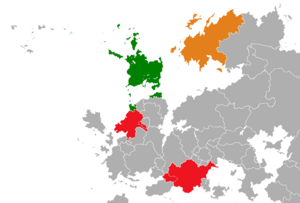Aldinean Cold War
| Aldinean Cold War | |||||||
|---|---|---|---|---|---|---|---|
 Sjealand Ambrose Major proxy conflict locations | |||||||
| |||||||
| Belligerents | |||||||
|
• Other allies and proxies: |
• Other allies and proxies: | ||||||
|
|
| ||||||
| Commanders and leaders | |||||||
|
(Marshal of the Sea of Njord) |
(Chief Air Marshal) | ||||||
| Units involved | |||||||
|
WADO Armed Forces: |
GCP Armed Forces: | ||||||
The Aldinean Cold War, sometimes referred to as the Ambrose-Sjealand Cold War, Aldinean conflict or the Ambrose-Sjealand conflict, is the ongoing struggle for influence and hegemony in Aldinea, the Lazarene Sea, as well as parts of Sirklant and Miklea, between the Archkingdom of Sjealand and Ambrosian Confederal Republic. The two great powers are the leaders of two opposing alliance systems, with Sjealand leading the West Aldinean Defence Organisation and Ambrose the Golden Circle Pact. These blocs have provided varying degrees of involvement in proxy wars across Midgard, including the War in Weichtal and the War in North Alaouasem.
Beginning in the early 1970s with the War of the Njord and the Engatian Split, the cold war has been waged on multiple levels over geopolitical, economic and cultural influence as both sides attempt to secure economic hegemony and political dominance over Aldinea. It has drawn significant lines between Aldinean states and even those abroad, as the two blocs have sought to extend their influence at the cost of the other. Its intensity has varied over the decades, with periods of détente in the late 1970s and early 2000s punctuated by outbreaks of violence such as the breakup of Valland and the 2018 Aldinean crisis.
Most observers draw a continuous line between the modern cold war and the 400-year long Ambro-Sjealandic rivalry, though some distinguish the current conflict from its historical predecessors by noting its roots in the aftermath of the Second Continental War. Certain figures have attempted to paint the conflict along ideological lines (such as republicanism v. monarchism), though critics of this approach note that both WADO and the GCP have both lent support to monarchies and republics alike. Others instead assert that the conflict is essentially materialistic in nature, reflecting the divide between globalised, traditionally-thalassocratic mercantile states and more insular, traditionally land-based states in favor of regional, not global, economic integration.